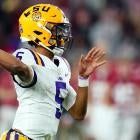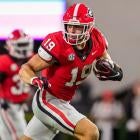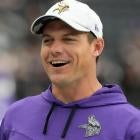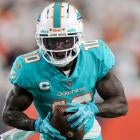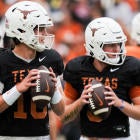Pac-12 commissioner Larry Scott said this week he will ask his ADs to consider a league-wide injury report policy.
It is a lofty goal, marking the first time I can remember a sitting commissioner being in favor of such a policy. One problem: It will never fly.
It will never fly until it flies everywhere else. The latest flap over injury reports bubbled up last week at Missouri at USC. Lane Kiffin suspended a reporter (since reinstated) for reporting on an injured kicker. (I thought only our editors could suspend us. Silly me.) At Missouri, coach Gary Pinkel did not disclose the fact that quarterback James Franklin had a sore shoulder.
(For those who argue he should have, Arkansas’ John L. Smith had no problem giving updates on Tyler Wilson, his supposedly concussed quarterback.)
All this became a national talking point when Scott finally said he would bring it up at the Pac-12’s October AD meetings. Even within his conference, there is disagreement.
“I think it’s a horrible idea,” said a mocking Mike Leach who does not give out injury information but reported Washington State quarterback Jeff Tuel was “ridiculously healthy.”
The NFL has an injury-reporting policy basically to keep the point-spread line square in Las Vegas.
“Obviously they would never admit that,” said Joel Staniszewski of Las Vegas Sports Consultants, the firm that sets the lines in Vegas.
In the pros, hiding injury information could make things really unsettled in the betting community. In that sense line-making is seen as a deterrent to betting improprieties. If there was a uniform policy amongst colleges, “I don’t think it would affect us so much because of technology,” according to Staniszewski.
He said his company monitors blogs and tweets (especially from players) to get up-to-date college injury information. If, that is, it isn’t released by the school. The Arkansas-Alabama line increased last week when Tyler Wilson was knocked out of the Louisiana-Monroe game with a head injury. While the school never did admit to a head injury it did provide regular participation updates after practice.
“That one -- beginning of the week to midweek -- we had a thought a feeling that he wasn’t going to play,” Staniszewski said. “As the week went on it became doubtful. We basically get the same stuff. Most books and oddsmakers or sports consultants have people that keep an eye on this stuff to see who is remarking on practice.”
There you go, another reason coaches are unlikely to divulge information: There is no moral imperative in the college ranks such as there is in the NFL. (Wilson was cleared to play against Rutgers on Thursday.)
But even if the Pac-12 somehow adopts a league-wide policy, it will never work. Either all 124 schools have to agree to a uniform injury-reporting format or none of them will. You think Nick Saban is going to share his injury report with a non-conference opponent who doesn’t discuss injuries?
That raises another – perhaps the biggest issue: Don’t expect the SEC to go along with this – at all, ever. It’s not just the football-crazy South, I doubt if the Big 12 or other BCS leagues would do it. Commissioners and ADs, you see, are loathe to pry into coaches’ business.
For years, most practices were open. That was before salaries weren’t as big, the Internet hadn’t been invented and perhaps there was an understanding that the beat writers wouldn’t report a broken leg by the starting quarterback.
When reporters and bloggers did start writing what they saw – what a concept! – coaches got nervous and started to close practice. I remember the long, loud protest when Bill Snyder threw up tarps around the Kansas State practice fields when he arrived in 1989. The joke going around was: Who would want to see that crap anyway?
But for us it’s about access, freedom of the press and dissemination of information. You know, the Constitution? Without that kind of stuff we’d be writing for sites approved by the government in Cuba. All we want is the option to watch practice. But the coaches have chosen to make this into so much of a national discussion that seems like it’s going to make its way into an Obama speech.
Let me pause here to say there are few activities more boring that watching a football practice. What we see we seldom understand. The time we waste in blistering heat and shivering cold watching players could be better spent. It was a laborious, tedious part of the job.
Most coaches have taken it away from us, while creating distractions of their own. Kiffin had to spend part of Stanford week meeting with newspaper editors trying to get that reporter reinstated. Pinkel could have avoided some controversy by merely mentioning his quarterback had a sore shoulder.
But that’s not the way coaches think. It’s all about deceiving the media, the public and the opponent. It smacks of high-school antics but there are few with the stones – especially their bosses -- to call them on it. These are still non-profit institutions of higher learning.
If there was a college football commissioner – a lofty goal – he could institute such a policy. It would be best for everyone – media, Las Vegas and the coaches themselves.
Larry Scott is one man, a man with a good plan but one that will die in committee.
Clash of the offensive titans
Plays per game by offenses coached by Rich Rodriguez and Chip Kelly since 1999 (See Friday’s Weekend Watch List):
Rodriguez
1999 – 69.1
2000 – 77.5
2001 – 75.6
2002 – 76.4
2003 – 65.5
2004 – 70.7
2005 – 68.2
2006 – 63.3
2007 – 68.7
2008 – 63.2
2009 – 65.8
2010 – 69.8
2011 – N/A
2012 – 93.3 (through three games)
Kelly
1999 – 79.9
2000 – 75.1
2001 – 79.4
2002 – 72.4
2003 – 77.3
2004 – 77.2
2005 – 75.4
2006 – 71.5
2007 – 79.1
2008 – 73.7
2009 – 68.1
2010 – 78.7
2011 – 72.5
2012 – 86.3 (through three games)












